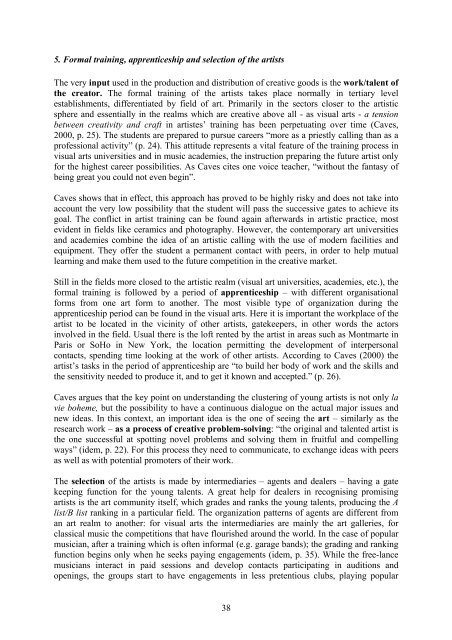Future of Creative Industries - Implications for Research ... - Europa
Future of Creative Industries - Implications for Research ... - Europa
Future of Creative Industries - Implications for Research ... - Europa
You also want an ePaper? Increase the reach of your titles
YUMPU automatically turns print PDFs into web optimized ePapers that Google loves.
5. Formal training, apprenticeship and selection <strong>of</strong> the artistsThe very input used in the production and distribution <strong>of</strong> creative goods is the work/talent <strong>of</strong>the creator. The <strong>for</strong>mal training <strong>of</strong> the artists takes place normally in tertiary levelestablishments, differentiated by field <strong>of</strong> art. Primarily in the sectors closer to the artisticsphere and essentially in the realms which are creative above all - as visual arts - a tensionbetween creativity and craft in artistes’ training has been perpetuating over time (Caves,2000, p. 25). The students are prepared to pursue careers “more as a priestly calling than as apr<strong>of</strong>essional activity” (p. 24). This attitude represents a vital feature <strong>of</strong> the training process invisual arts universities and in music academies, the instruction preparing the future artist only<strong>for</strong> the highest career possibilities. As Caves cites one voice teacher, “without the fantasy <strong>of</strong>being great you could not even begin”.Caves shows that in effect, this approach has proved to be highly risky and does not take intoaccount the very low possibility that the student will pass the successive gates to achieve itsgoal. The conflict in artist training can be found again afterwards in artistic practice, mostevident in fields like ceramics and photography. However, the contemporary art universitiesand academies combine the idea <strong>of</strong> an artistic calling with the use <strong>of</strong> modern facilities andequipment. They <strong>of</strong>fer the student a permanent contact with peers, in order to help mutuallearning and make them used to the future competition in the creative market.Still in the fields more closed to the artistic realm (visual art universities, academies, etc.), the<strong>for</strong>mal training is followed by a period <strong>of</strong> apprenticeship – with different organisational<strong>for</strong>ms from one art <strong>for</strong>m to another. The most visible type <strong>of</strong> organization during theapprenticeship period can be found in the visual arts. Here it is important the workplace <strong>of</strong> theartist to be located in the vicinity <strong>of</strong> other artists, gatekeepers, in other words the actorsinvolved in the field. Usual there is the l<strong>of</strong>t rented by the artist in areas such as Montmarte inParis or SoHo in New York, the location permitting the development <strong>of</strong> interpersonalcontacts, spending time looking at the work <strong>of</strong> other artists. According to Caves (2000) theartist’s tasks in the period <strong>of</strong> apprenticeship are “to build her body <strong>of</strong> work and the skills andthe sensitivity needed to produce it, and to get it known and accepted.” (p. 26).Caves argues that the key point on understanding the clustering <strong>of</strong> young artists is not only lavie boheme, but the possibility to have a continuous dialogue on the actual major issues andnew ideas. In this context, an important idea is the one <strong>of</strong> seeing the art – similarly as theresearch work – as a process <strong>of</strong> creative problem-solving: “the original and talented artist isthe one successful at spotting novel problems and solving them in fruitful and compellingways” (idem, p. 22). For this process they need to communicate, to exchange ideas with peersas well as with potential promoters <strong>of</strong> their work.The selection <strong>of</strong> the artists is made by intermediaries – agents and dealers – having a gatekeeping function <strong>for</strong> the young talents. A great help <strong>for</strong> dealers in recognising promisingartists is the art community itself, which grades and ranks the young talents, producing the Alist/B list ranking in a particular field. The organization patterns <strong>of</strong> agents are different froman art realm to another: <strong>for</strong> visual arts the intermediaries are mainly the art galleries, <strong>for</strong>classical music the competitions that have flourished around the world. In the case <strong>of</strong> popularmusician, after a training which is <strong>of</strong>ten in<strong>for</strong>mal (e.g. garage bands); the grading and rankingfunction begins only when he seeks paying engagements (idem, p. 35). While the free-lancemusicians interact in paid sessions and develop contacts participating in auditions andopenings, the groups start to have engagements in less pretentious clubs, playing popular38














